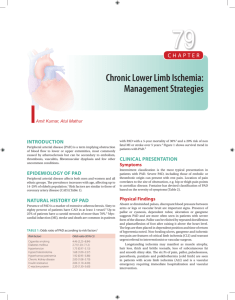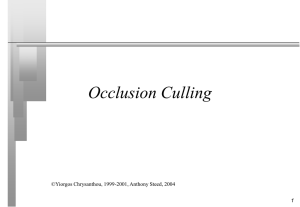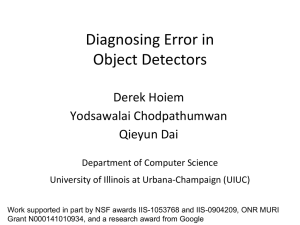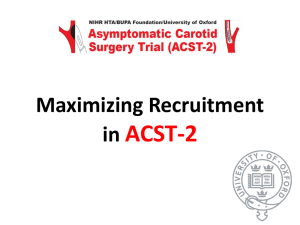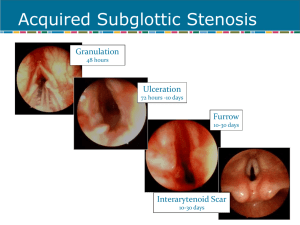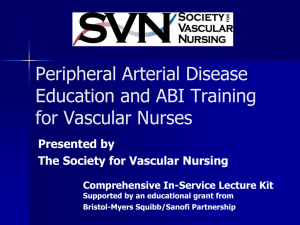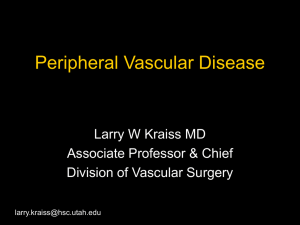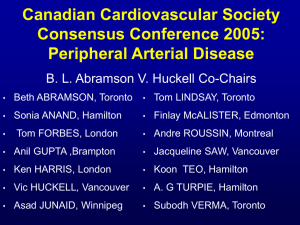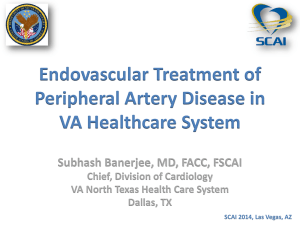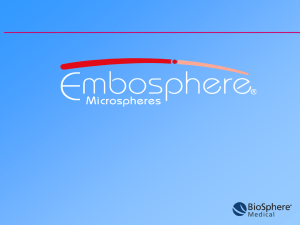PAD
advertisement
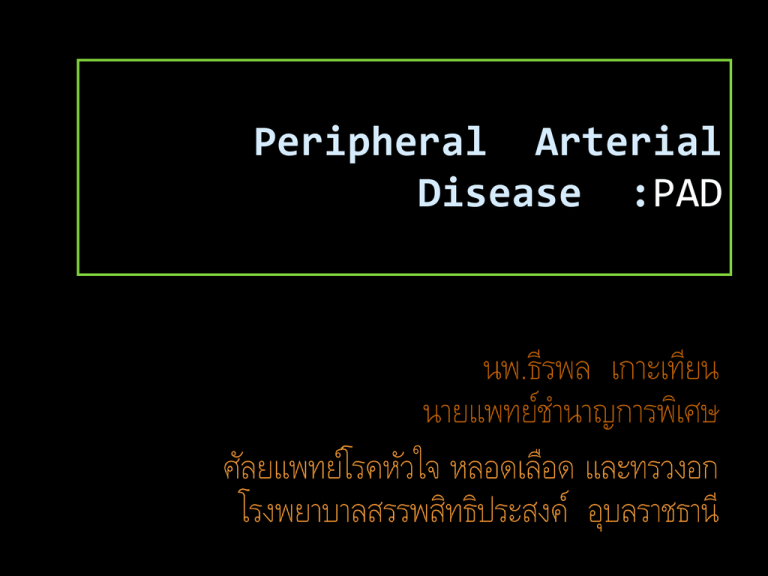
Peripheral Arterial Disease :PAD Introduction PAD caused by atherosclerotic occlusion of arteries to legs Prevalence 12% and increases to 20% if persons older than 70 yr. Affects men and women equally pt. with PAD , even absence of Hx of MI or ischemic stroke have same relative risk of death from CVS cause as pt. with Hx of CAD or CVD Introduction Rate of death of all causes equal in men and women and is elevated even in asymptomatic pt. Severity of PAD is closely associated with risk of MI , ischemic stroke , and death from vascular cause Lower ABI – greater risk of CVS events Critical leg ischemia – mortality of 25% RISK FACTOR Smoking DM HT Hypercholesterolemia Normal Artery and Artery With Plaque Buildup PAD Male Female 4% 8% Risk Factor Age DM > 12 yrs HT in THAILAND A Life Threatening Condition The REACH (Reduction of Atherothrombosis for Continued Health) Registry has expanded mortality associated with PAD At one year, 19% of the PAD population had experienced either an MI, a stroke or were hospitalised for an atherothrombotic event or had died from CV causes compared to 10% of the CAD population and 7% of CVD population. PAD vs DM DM ทำให้เพิ่มควำมชุกของ PAD 2เท่ำ 1.5% ของผูป้ ่ วย DM จะถูกตัดนิ้ ว ขำ 50% จะถูกตัดเพิ่ม 50% ถูกตัดอีกข้ำง ภำยใน 2 ปี 50% ที่ถกู ตัดขำ เสียชีวติ ภำยใน 5 ปี Clinical Staging of LEAD Screening for PAD ABI Selection of patient high risk DM Age 50 years. Ankle-Brachial Index (ABI) INTERPRETATION NORMAL 0.9 -1.30 MILD 0.7-0.89 MODERATE 0.4-0.69 SEVERE < 0.4 POORLY COMPRESSIBLE > 1.3 TREATMENT งดสูบบุหรี่ ออกกำลังกำย ควบคุม ควำมดัน (140/90 mmHg) LDH < 100 Medication Endovascular treatment Surgery กำรประเมินผูป้ ่ วยที่มีอำกำร Claudication ผูป้ ่ วยทีม่ อี ำกำรแบบ classic claudication ตรวจร่ำงกำยระบบหลอดเลือด ตรวจ resting ankle - brachial index (resting ABI) ABI ≤ 0.90 ABI > 0.90 - Exercise ABI - Toe-brachial index - Segmental pressure measurement - Duplex ultrasound exam. Confirmation of PAD diagnosis - Risk factors normalization - Pharmacological risk Abnormal results กำรรักษำภำวะ claudication Normal results No PAD or consider arterial entrapment syndrome Intervention of PAD Toe gangrene in a patient with diabetes AORTO-ILIAC LESIONS Lesion type Type A Description * Unilateral or bilateral stenosis of CIA * Unilateral or bilateral single short (≤3cm) stenosis of EIA * Short (≤3cm) stenosis of infrarenal aorta Type B * Unilateral CIA Occlusion * Single or multiple stenosis totaling 3-10cm. Involving the EIA occlusion not involving the origins of internal iliac of CFA AORTO-ILIAC LESIONS Lesion type Description * Bilateral CIA occlusion * Bilateral EIA stenosis 3-10cm long not extending into the CFA Type C * Unilateral EIA stenosis extending tnto the CFA * Unilateral EIA occlusion that involves the origins of internal iliac and/or CFA * Heavily calcified unilateral EIA occlusion with or without involvement of origins of internal iliac and/or CFA * Infra-renal aorto-iliac occlusion Type D * Diffuse disease involving the aorta and both iliac arteries requiring treatment * Diffuse multiple stenosis involving the unilateral CIA, EIA and CFA * Unilateral occlusions of both CIA and EIA * Bilateral occlusion of EIA * Iliac stenosis in patients with AAA requiring treatment and not amenable to endograft placement or other laesions requiring open aortic or iliac surgery FEMORAL-POPLITEAL LESIONS Lesion type Description * Single stenosis ≤10cm in length Type A * Single occlusion ≤5cm in length * Multiple lesions (stenoses or occlusion),each ≤5cm Type B * Single stenosis or occlusion ≤15cm not involving the infra geniculate popliteal artery * Single or multiple lesions in the absence of continuous tibial vessels to improve inflow for a distal bypass * Heavily calcified occlusion ≤5cm inlength * Single popliteal stenosis FEMORAL-POPLITEAL LESIONS Lesion type Type C Type D Description * Multiple stenoses or occlusions totaling >15cm with or without heavy calcifications * Recurrent stenoses or occlusion that need treatment after two endovascular interventions * Chronic total occlusion of CFA of SFA (>20cm, involving the popliteal artery) * Chronic total occlusion of popliteal artery and proximal trifurcation vessels THANK YOU Question ?
